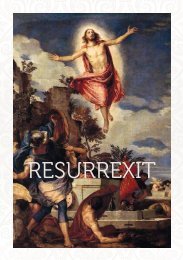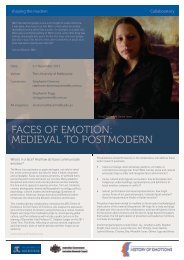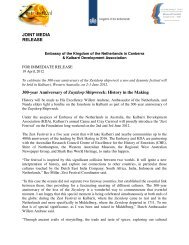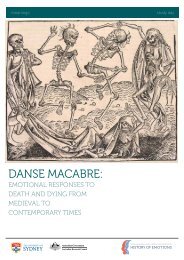Download our K-12 education pack - ARC Centre of Excellence for ...
Download our K-12 education pack - ARC Centre of Excellence for ...
Download our K-12 education pack - ARC Centre of Excellence for ...
Create successful ePaper yourself
Turn your PDF publications into a flip-book with our unique Google optimized e-Paper software.
Supporting Res<strong>our</strong>ces stories <strong>for</strong> teachers & students 2013<br />
Dutch Lives in the World<br />
stories by winthrop pr<strong>of</strong>essor susan broomhall<br />
The Vereenigde Oost-Indische<br />
Compagnie (VOC)<br />
Dutch exploration and encounters around the world during the<br />
seventeenth and eighteenth centuries were filled with emotions,<br />
many <strong>of</strong> them mixed. Thanks to the immense success <strong>of</strong> the<br />
Dutch East India Company, the Dutch Provinces at this time were<br />
much wealthier than other nations in Europe. The Dutch were<br />
very proud <strong>of</strong> their global reach <strong>for</strong> such a small nation. The<br />
Dutch East India Company was like the world’s first<br />
multinational, and major brand. It inspired many emotions at the<br />
time: joy, pride, elation, triumph, jubilation, satisfaction, selfconfidence,<br />
generosity, but also a great deal <strong>of</strong> envy and greed.<br />
The Dutch were also careful to recognise God’s all-important<br />
role in the protection <strong>of</strong> their nation. VOC letters regularly ended<br />
with variations on ‘May God Almighty preserve all y<strong>our</strong> worships’<br />
ships from accidents and bring them safe to port’J54.<br />
The VOC was set up in 1602 to help Dutch traders and explorers<br />
work together in an organised way to find and supply spices<br />
across the world <strong>for</strong> the good <strong>of</strong> the whole nation. But it was not<br />
the only company that had this purpose. When the Dutch<br />
company started up, they were competing with the Portuguese<br />
and Spanish who were considered the most advanced explorers<br />
and traders <strong>of</strong> their era in Europe. Later, the Dutch were so<br />
successful in organising their business that other European<br />
nations wanted to join in. There was competition from the<br />
English, Danish, Swedish, and French among others. Some<br />
companies failed (like the Ostend company which represented<br />
what is now Belgium) but none were quite as successful as the<br />
Dutch in their time.<br />
The VOC was like a big, global business; it set up trading posts<br />
all over the world, trading with countries we now call South<br />
Africa, Sri Lanka, India, Indonesia, Malaysia, China and Japan,<br />
and it employed over 30 000 people which was a lot when there<br />
were only about 2 million Dutch altogether.<br />
brought goods to them at their other outposts. In Japan, the<br />
Shogun limited their trade to a small island called Deshima in<br />
Nagasaki harb<strong>our</strong>. The Japanese weren’t at all sure that trade<br />
with Europeans would be good <strong>for</strong> them and they kept a close<br />
eye on all their activities.<br />
Sometimes, the Dutch set up bases that would be<br />
useful stopping <strong>of</strong>f points <strong>for</strong> their ships. Cape Town in South<br />
Africa was a good half-way point where their ships could take on<br />
fresh water and supplies, and their sailors stretch their legs a<br />
little be<strong>for</strong>e the long j<strong>our</strong>neys either across the Indian Ocean to<br />
India or Indonesia, or back home to The Netherlands. They did<br />
like the flowers and plants there though, and the Cape supplied<br />
many unique bulbs and other exotic plants <strong>for</strong> wealthy<br />
Europeans’ gardens.<br />
The Dutch didn’t see much that they could trade on the<br />
occasions that they were wrecked on the west coast <strong>of</strong> Australia,<br />
although crews were recommended to look out <strong>for</strong> fabled gold<br />
that was said to be in the great Southland, and kept items such<br />
as linen, mirrors, beads, bells and even toys <strong>for</strong> trading with<br />
indigenous peoples they might meet. There wasn’t much in the<br />
landscape that was familiar to their watery homes, or the lush<br />
islands <strong>of</strong> South-East Asia, although Willem de Vlamingh rather<br />
liked what he saw in 1696-7 and made notes about some s<strong>our</strong>ces<br />
<strong>of</strong> fresh water, good supplies <strong>of</strong> fish, a funny little rat on an<br />
island the sailors called Rats’ Nest (Rottnest) and swans a col<strong>our</strong><br />
they’d never seen in a river they named Swan River. Mostly<br />
though, the Dutch wanted to hop straight back on the boats they<br />
had left, or could re-build, and headed up north to their base in<br />
Indonesia called Batavia (we know it as Jakarta now).<br />
So what were the Dutch looking to trade Anything that could<br />
make them a pr<strong>of</strong>it, not just back home, but also between ports<br />
in Asia. Of c<strong>our</strong>se, spices such as pepper from India and<br />
Indonesia, cinnamon from Ceylon, nutmeg and mace from the<br />
Banda Islands and cloves from Ambon were key. Many were not<br />
just exotic to Europeans; some <strong>of</strong> them grew only in limited<br />
areas, and could fetch a high price within Asia to be exchanged<br />
with local goods that could be shipped back home.<br />
Textiles were also vital, ranging from fine Indian cloth and<br />
Chinese, Japanese silks, and Persian rugs to the coarser Guinea<br />
cloth which could be exchanged on the African coast <strong>for</strong> slaves.<br />
Japan emerged as an important early supplier <strong>of</strong> precious<br />
metals, as gold, silver, tin and copper were also passed between<br />
Asian ports by the Dutch, as well as porcelain from China and<br />
even Ceylon elephants which could be pr<strong>of</strong>itably sold on to Indian<br />
monarchs. In the eighteenth century, tea and c<strong>of</strong>fee became a<br />
more dominant part <strong>of</strong> the cargo, while the VOC directors also<br />
sought solutions to draw previously illicit trades such as opium<br />
and elephant tusks into the company’s pr<strong>of</strong>its.<br />
But the Dutch weren’t always able to get what they wanted. They<br />
found produce made in the empires <strong>of</strong> China and Japan much<br />
harder to access. In the end, they gave up trying to get a firm<br />
foothold in China and settled <strong>for</strong> trading with junks which<br />
56 FAR FROM HOME: ADVENTURES, TREKS, EXILES & MIGRATION












